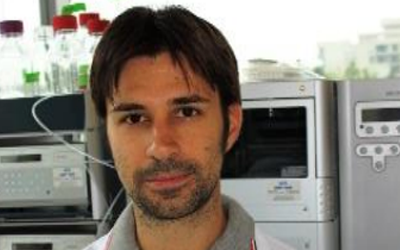Clinical ethicist Kim Jameson is investigating the need for advance care planning discussions for people with Parkinson’s disease. Many patients expressed that their doctors had not initiated conversations about long-term or end-of-life care. Jameson aims to identify the barriers preventing doctors from starting these discussions and develop patient-centered guidelines for these conversations.
Research
Investigating the Therapeutic Mechanisms of Exercise Interventions for the Treatment of Parkinson’s Disease
Jul 5, 2016 | Research
Neuroscientist Matthew Sacheli is researching how exercise helps alleviate symptoms of Parkinson’s disease. Inspired by observing a patient whose symptoms improved with exercise, he is studying the brain’s response to physical activity. Using PET and fMRI imaging, he aims to identify how exercise influences dopamine release and which brain regions are involved.
Morphological and Electrophysiological Investigation of the Role of LRRK2 in Activity-Dependent Striatal Synaptic Plasticity
Apr 8, 2016 | Research
Naila Kuhlmann, a graduate student at the University of British Columbia, is studying the plasticity of neurons in the striatum, a brain region affected in Parkinson’s disease. She focuses on the effects of LRRK2 gene mutations, a common genetic cause of the disease, on neuron structure. Specifically, she examines dendrites and spines, which are key to neural communication. Kuhlmann aims to understand how these structural changes impact dopamine transmission and how early interventions targeting these changes could prevent or slow Parkinson’s progression.
Novel Retromer Cargo Trafficking, Synapse Maintenance, and Plasticity in the Context of Parkinson’s Disease Mutations
Feb 2, 2016 | Research
Chelsie Kadgien, a researcher focused on Parkinson’s disease, is studying how mutant forms of the VPS35 protein might affect brain cell communication. She believes that these mutations cause cells to have too many receptors, leading to an overload of communication, which ultimately exhausts and kills the cells. By confirming this theory using cell cultures and animal models, she hopes to pave the way for new treatments.
Survival of Dopamine Neurons in Parkinson’s Disease: The Role of Synaptic Contacts
Dec 15, 2015 | Research
Charles Ducrot, a PhD student at the University of Montreal, is investigating the role of synapses in the vulnerability of dopamine-producing neurons in Parkinson’s disease. He theorizes that neurons in the brain’s ventral tegmental area (VTA) survive longer than those in the substantia nigra due to forming more glutamate synapses, which allow better communication and survival signals.
The Physiology of LRRK2 and the Pathophysiology of Parkinson’s Disease: LRRK2 Silencing as a Treatment Strategy
Oct 7, 2015 | Research
In recent years, researchers have made significant progress in identifying genetic causes of familial Parkinson’s disease, focusing on how gene mutations affect brain cell communication. Austen Milnerwood, a neuroscientist at the University of British Columbia, is studying how these mutations disrupt normal brain activity, particularly mutations in the LRRK2 gene, which cause brain cells to become hyperactive.
The Role of LRRK2 in the Development and Transmission of Acute Alpha-Synuclein Neuropathology
Jul 14, 2015 | Research
Neuroscientist Mattia Volta at the University of British Columbia is investigating the relationship between the proteins alpha-synuclein and LRRK2 in Parkinson’s disease. Using animal models missing the LRRK2 protein, Volta has found that mice without LRRK2 are protected from cognitive impairments and memory loss caused by alpha-synuclein clumps. He is now exploring whether the absence of LRRK2 also prevents motor problems and disease progression in Parkinson’s.
A Novel fMRI Approach to Investigating the Pathophysiology of Postural Instability in Parkinson’s Disease
Jul 8, 2015 | Research
Balance issues leading to falls are a significant challenge for people with Parkinson’s disease, not resolved by current treatments. At the University of British Columbia, neuroscientist Mark Carpenter is studying why balance problems persist and whether they are controlled by different brain regions than other motor functions.
Genetic and Neuroimaging Markers for Parkinson Disease: Correlation with Clinical Phenotype and Outcomes
Feb 24, 2015 | Research
Dr. Daryl Wile, a neurologist at the University of British Columbia, is working on developing an early diagnostic test for Parkinson’s disease using Positron Emission Tomography (PET). He aims to identify brain changes in people with a mutated LRRK2 gene before they develop symptoms like tremors or rigidity. By studying neurotransmitter activity in the brain, Wile hopes to understand how Parkinson’s progresses early on.









